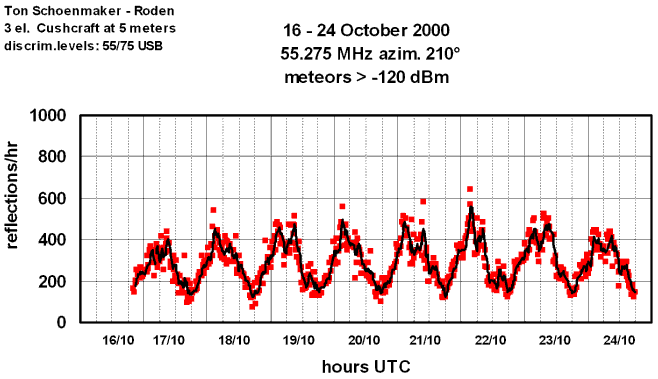|
Carl Johannink : visual observations Ton Schoenmaker : forward scatter meteor observations |
We are now in the midst of the Orionids stream. Weather in the Netherlands is quite good for tourist activities. It's rather warm, dry and with some little sunny spells especially in the eastern part of the country. The western part is mostly cloudy. This is no good weather for observing Orionids as we experience lots of high clouds.
Hi again! It's the night of sunday/monday 23/24 october now. The western part of the Netherlands is covered by an altocumules cloudlayer. The eastern part is mostly clear. Observers in that last area are in the position to observe the Orionids. We received an e-mail from Arnold Tukkers who is preparing for an observing session. Hans Betlem and kids too are located in the eastern part of the country and should be able to do some observation right now. More later....
Carl Johannink, Gronau
*Date : 22/23-10-00
*Observer: Johannink, Carl (IMO-code: JOHCA)
*Place : Gronau (Germany)
*Coord. : 7o 01'E ; 52o13'N
*Center : R.A.=4h40m; Decl.=70 deg. at 01:30 UT
*Start : 01:17 UT
*End : 02:58 UT
*Teff : 1.68 hours
Time(UT) : Ori: Tau: sp: n: LM: Notes:
01:17-02:02 7 1 8 16 5.8 0.75 hours ; 20% clouds for 5min.
02:02-02:58 5 1 9 15 5.6 0.93 hours ; 2:50 10% clouds ; 2:58 40% clouds
<-2 -2 -1 0 1 2 3 4 5 6 m: n:
ORI. 0 0 0 0 2 3 2 2 3 0 3.08 12
TAU. 0 0 0 0 0 0 0 2 0 0 4.00 2
EGE. 0
spor. 0 0 0 0 0 2 5 8 2 0 3.59 17
----------------------------------------------
C.F. Johannink
Schiefestrasse 36
48599 Gronau
Germany
Phone: + 49 2562 22345
Email: cjohannink@netside.de
----------------------------------------------
Ton Schoenmaker, Roden
Forward Scatter Meteor Observations of Orionids 2000
Observer : Ton Schoenmaker
Location : Roden, Netherlands (06 26' E, 53 08' N)
Frequency : 55.275 MHz
Transmitter: Spanish TV channel E3 (video);
transmitters in La Muela (30 kW),
Gamoniteiro (50 kW) and Aitana (60 kW);
all stations within 100 Hz of nominal frequency;
distance about 1650 km
Antenna : 3-elements horizontal Cushcraft Yagi,
geographical azimuth 210 degrees (SW)
Receiver : Yupiteru MVT-9000 in USB mode;
sensitivity 0.5 ÁV at 12 dB S/N
Observing : audio signal from earphone socket was rectified,
digitised and fed into a PC via the parallel computer port.
HP VEE was used to process the digitised signal
and to store 15-minutes counts of reflections
stronger than 0.22 ÁV (-120 dBm).
Of each meteor stronger than the threshold also time,
maximum strength and signal duration
at the threshold level were registered.
Although the Orionids are not known as a very active meteor shower, I hoped to observe an increase in the counts around October 21st. Automatic meteor observation were performed continuously from 16 through 24 October 2000. Occasionally the measurements were interfered by Sporadic-E or Tropo. Periods with a dead time of more than 5 minutes (of a 15 minutes period) have been deleted.

The figure shows all reflections with duration of at least 0.1 seconds and signal strength stronger than -120 dBm. Each plotted square represents the number of counts per 15 minutes multiplied by 4 to convert to hourly rates. The black line is the 4-point running average. For the midpoint between The Netherlands and Spain the radiant of the Orionids rises at 21h UTC and sets at 11h UTC. The theoretically most favourable observability for the Draconids is around 3h UTC and 7h UTC with a low observability around 5h UTC. Unfortunately the maximum observability takes place around the daily maximum of the sporadics. Nevertheless the counts around 21/22 October show increased activity of the Orionids of about 100 meters/hour. Some structure is visible around the daily maximum, and it is tempting to explain this as the observability function of the Orionids. But a similar structure was also present around October 8th (see Draconids somewhere else on this website), so this is probably not caused by the Orionids.
Ton Schoenmaker, Dutch Meteor Society
Meester Homanstraat 8, NL-9301 HP Roden, Netherlands
E-mail: schoenmaker@NFRA.nl
Call: PA0EFA